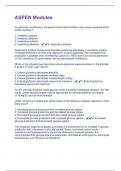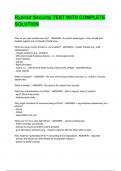In pulmonary insufficiency, excessive calorie administration may cause increased blood
pCO2 resulting in
1: metabolic acidosis
2: metabolic alkalosis
3: respiratory acidosis
4: respiratory alkalosis - ✔️✔️3: respiratory acidosis
Respiratory acidosis results from disorders producing alterations in ventilatory control,
increased production of CO2, and respiratory muscle weakness. The increased CO2
production is greatest when overfeeding occurs (2 x REE) due to an excess generation
of CO2 relative to O2 consumption during carbohydrate metabolism.
Which of the following best describes enteral glutamine supplementation in the critically
ill patient in multi organ failure?
1: Enteral glutamine decreases mortality
2: Enteral glutamine decreases ventilator days
3: Enteral glutamine decreases hospital length of stay
4: Enteral glutamine decreases nosocomial infections - ✔️✔️4: Enteral glutamine
decreases nosocomial infections
For the critically ill patient, blood glucose levels should be maintained between 140-180
mg/dL. Lower glucose targets may be appropriate for selected patients, but targets
<110 mg/dL are not recommended
Under conditions of sepsis and stress, which of the following metabolic alterations most
likely occur?
1: Increased glucose production and increased glucose uptake
2: Increased glucose production and decreased glucose uptake
3: Decreased glucose production and decreased glucose uptake
4: Decreased glucose production and increased glucose uptake - ✔️✔️2: Increased
glucose production and decreased glucose uptake
The metabolic response to sepsis and stress is characterized by an increase in glucose
production and a decrease in glucose uptake. Stress hormones induce insulin
resistance and hyperglycemia is commonly observed in stressed patients. It is
recommended that glucose levels be adequately controlled to avoid polyuria, electrolyte
disturbances, and infectious complications.
,Which of the following immunomodulating nutrients may be harmful in patients with
sepsis/septic shock?
1: Arginine
2: Selenium
3: Nucleic acids
4: Omega-3 fatty acids - ✔️✔️1: Arginine
Arginine is a major substrate for nitric oxide production. Under normal conditions, small
quantities of nitric oxide have a beneficial effect on immune function and tissue
oxygenation. Thus, arginine is considered an "immune-enhancing" agent. However,
nitric oxide can be detrimental by leading to coagulation abnormalities and altered
hemodynamic status. In this case, arginine could be considered harmful for patients
with sepsis/septic shock. Because of these effects, there is still much debate over the
value of arginine in nutrition support for critically ill patients.
A recent meta-analysis investigated the impact of glutamine-supplemented nutrition on
the outcomes of critically ill patients and found that glutamine supplementation did not
decrease mortality and length of hospital stay in critically ill patients. However,
glutamine supplementation did reduce nosocomial infections among critically ill patients.
Which of the following is the inpatient glycemic target for critically ill patients?
1: 80-110 mg/dL
2: 140-180 mg/dL
3: 181-210 mg/dL
4: 211-240 mg/dL - ✔️✔️2: 140-180 mg/dL
Which of the following are counter-regulatory hormones responsible for the
hypercatabolism observed in critically ill trauma patients?
1: Glycogen, insulin, norepinephrine
2: Glucagon, epinephrine, cortisol
3: Glycerol, serotonin, thymoglobulin
4: Glycerin, leptin, adenosine - ✔️✔️2: Glucagon, epinephrine, cortisol
The inflammation following a traumatic injury provokes a release of systemic catabolic
hormones including epinephrine, glucagon, and cortisol. These hormones are
responsible for glycogenolysis, gluconeogenesis, proteolysis, and free fatty acid
release. The goal of this metabolic response is to maintain survival and homeostasis
and promote recovery. Therapeutic intervention is geared toward blunting the
inflammatory response without making the patient susceptible to immunosuppression.
Timely resuscitation, including restoration of perfusion, oxygenation, and hemodynamic
,stability is the top priority. The early initiation of nutrition is an important component of
supportive therapy in the care of the trauma patient.
In patients with burns, providing caloric support above energy expenditure has been
found to
1: significantly decrease hospital length of stay
2: improve wound healing and graft success
3: decrease fat accumulation and steatosis
4: have no effect on preservation of lean body mass - ✔️✔️4: have no effect on
preservation of lean body mass
The metabolic stress that occurs in burn injury generates a hypercatabolic state that
increases energy expenditure. Although patients with burns have increased needs,
feeding in excess of energy expenditure may cause hyperglycemia, hepatic steatosis,
and prolonged ventilator dependence. One study of critically ill burn patients showed
that caloric delivery beyond 1.2 x REE did not conserve lean body mass but did
increase fat mass.
Which of the following is true of essential fatty acid deficiency (EFAD) in patients with
cystic fibrosis (CF)?
1: Routine supplementation of omega-3 fatty acids is essential in the management of
CF
2: EFAD usually does not manifest in CF patients until the second decade.
3: CF patients without pancreatic insufficiency rarely develop EFAD
4: EFA profiles have been shown to improve in CF patients after lung transplantation -
✔️✔️4: EFA profiles have been shown to improve in CF patients after lung
transplantation
Disruption in the exocrine function of the pancreas leads to malabsorption of fat, protein,
and fat-soluble vitamins in CF patients. EFAD may contribute to inflammatory pathways
contributing to the pulmonary and gastrointestinal symptoms associated with CF. The
overt signs of EFAD (scaly dermatitis, alopecia, thrombocytopenia, and growth failure)
are uncommon in patients with CF. EFAD correlates with poor growth and pulmonary
status. EFA status is usually evaluated by measuring the triene: tetraene ratio. Although
supplementation with omega-3 fatty acids are sometimes used in the management of
CF, results from clinical trials have shown mixed results and further trials are needed to
determine the efficacy of routine EFA supplementation in the management of CF.
Which of the following is the best choice for feeding a pancreatic insufficient infant with
cystic fibrosis?
1: Protein hydrolysate formula with medium chain triglyceride (MCT)
2: Free amino acid formula with MCT
, 3: Human milk
4: Standard infant formula - ✔️✔️3: Human milk
Human milk is the optimal choice over standard formula for any infant due to multiple
beneficial components including immunologic properties, growth factors, and both pre-
and probiotics. Human milk or standard infant formula with appropriate enzyme dosing
is recommended. Protein hydrolysate or free amino acid formulas containing MCT are
not indicated for infants with cystic fibrosis (CF) unless there is another medical reason
(such as bowel resection) resulting in malabsorption or liver abnormalities.
What is the glomerular filtration rate (GFR) of a patient with end-stage renal disease?
1: >90 mL/min/1.73 m2
2: 30-59 mL/min/1.73 m2
3: 15-29 mL/min/1.73 m2
4: <15 mL/min/1.73 m2 - ✔️✔️4: <15 mL/min/1.73 m2
Stage 1: >90
Stage 2: 60-89
Stage 3: 30-59
Stage 4: 15-29
Stage 5: <15 or dialysis
Increased mortality in maintenance HD patients has been associated with
1: low baseline body fat percentage and low muscle mass.
2: elevated albumin and decreased CRP values.
3: increased BMI.
4: increased serum cholesterol. - ✔️✔️1: low baseline body fat percentage and low
muscle mass
Low muscle mass reflects poor nutrition status and can reflect inflammation. Low fat
mass reflects low body stores of energy. Elevated CRP levels are increased with HD
and cause greater weight loss, decreased albumin, and decreased appetite. A BMI of
30-34.9 is considered protective in HD patients. A BMI <23 and hypoalbuminemia (<3.2
g/dL) are strong predictors of mortality in HD patients. Serum cholesterol is inversely
correlated with risk for death. It has been noted that serum cholesterol concentration is
elevated in long-term dialysis survivors.
Which of the following has NOT been shown to delay weaning from mechanical
ventilation in patients with chronic obstructive pulmonary disease who are receiving
enteral nutrition?
1: Refeeding syndrome
2: Trophic feeding
3: Underfeeding




